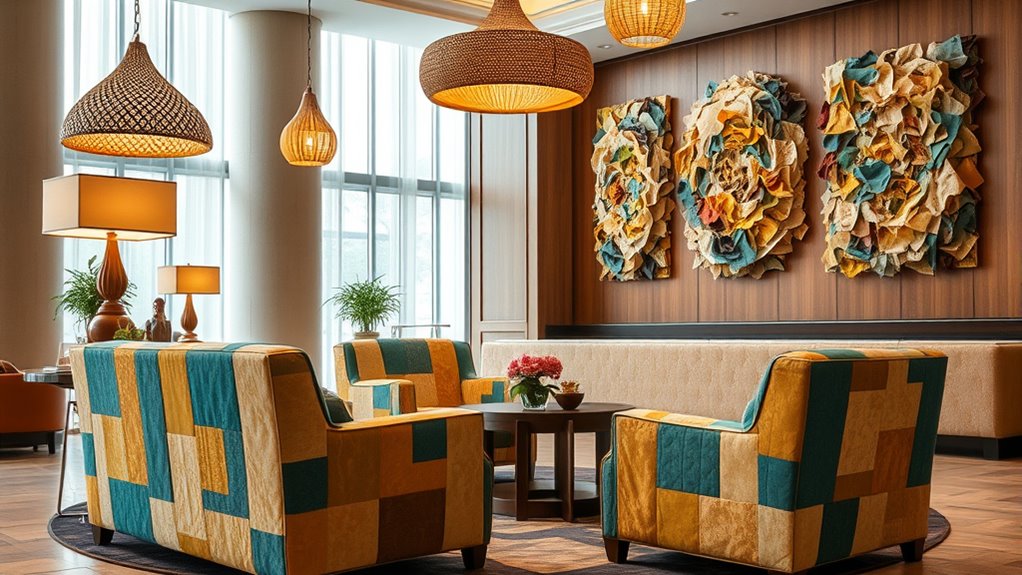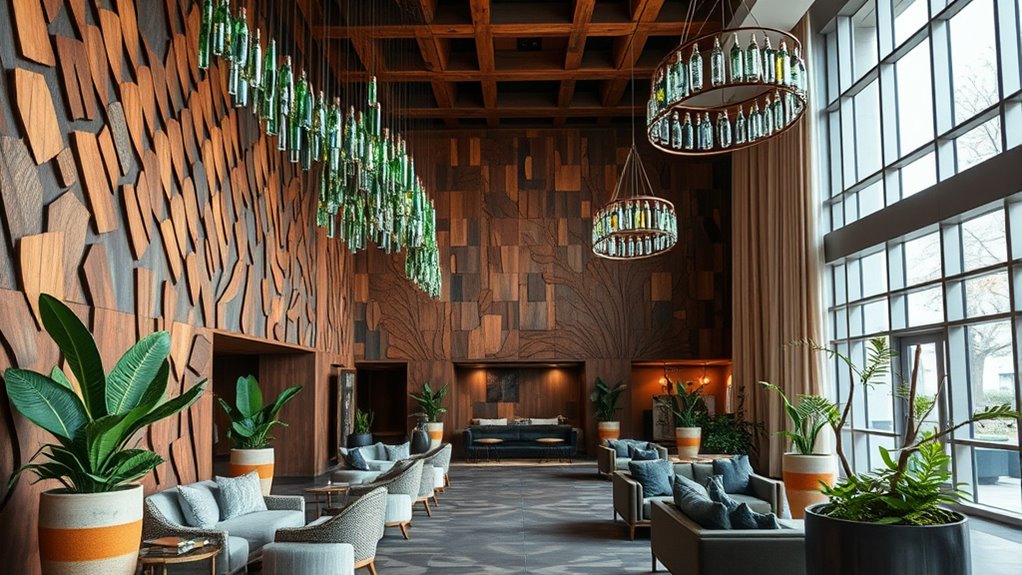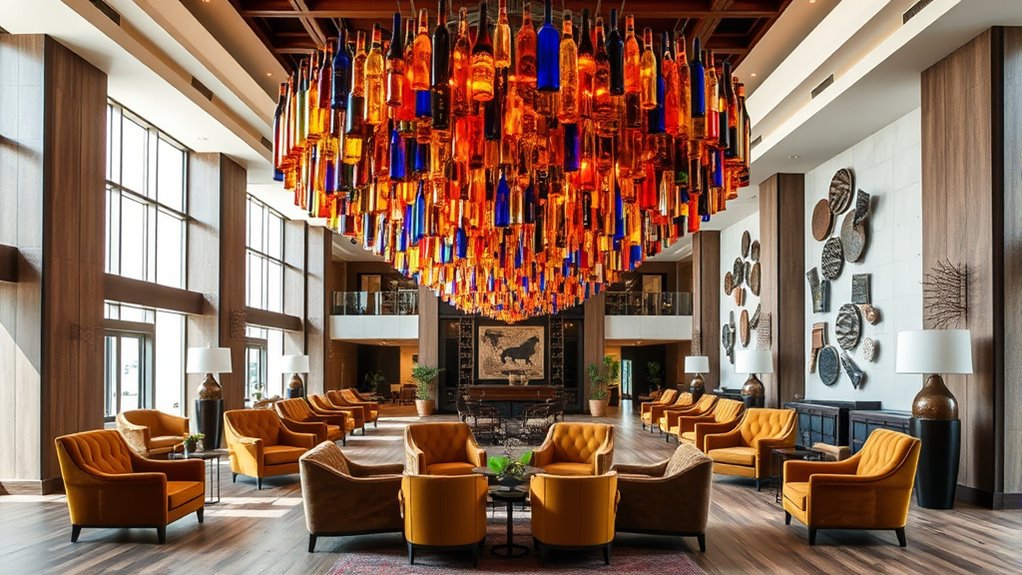Upcycled decor in luxury hotels combines sustainability with authentic aesthetic appeal, creating environmentally responsible spaces that stand out. You’ll find materials like reclaimed wood, recycled metals, and textiles transformed into unique furniture, lighting, and art pieces. Embracing natural flaws and weathered finishes adds charm and character while reducing waste. Explore how innovative reuse boosts brand appeal and guest loyalty, and discover inspiring examples of eco-conscious design that can elevate your space even further.
Key Takeaways
- Incorporate recycled metals, wood, and textiles to create sustainable, character-rich decor that aligns with eco-friendly luxury standards.
- Embrace natural flaws and weathered finishes to enhance authenticity, reduce maintenance, and support circular design principles.
- Use salvaged items and upcycled furniture to craft unique, story-telling interiors that showcase craftsmanship and environmental responsibility.
- Transform waste materials into functional art and fashion, elevating aesthetics while minimizing environmental impact.
- Integrate eco-friendly technologies such as LED lighting and smart fixtures to improve efficiency and reinforce sustainability commitments.
The Rise of Upcycled Materials in Hospitality Settings

The rise of upcycled materials in hospitality settings reflects a growing commitment to sustainability and innovative design. You’ll notice how luxury craftsmanship elevates recycled elements, transforming waste into sophisticated decor. Material durability plays a key role; recycled metals like aluminum and steel offer strength and longevity, making them ideal for furniture and fixtures. Upcycled materials not only cut waste—diverting large quantities from landfills—but also profoundly reduce energy consumption, such as saving up to 95% energy with recycled aluminum. This approach aligns with circular design principles, helping hotels improve environmental performance and reduce resource extraction. Using durable materials ensures long-lasting quality, which is essential for maintaining a luxury aesthetic. By embracing upcycled decor, you create spaces that are both eco-friendly and visually compelling, appealing to eco-conscious guests seeking authentic, well-crafted experiences.
Unique Textures and Imperfections as Design Features

You’ll notice that natural flaws and weathered finishes add character and authenticity to your space. These imperfections, like cracks or uneven textures, aren’t defects—they’re deliberate design features that tell a story. Embracing them creates a warm, unique environment that feels genuine and thoughtfully crafted. Incorporating natural, earthy tones further enhances the sense of authenticity and connection to the environment. Recognizing the importance of emotional regulation in design, these textures can evoke comfort and familiarity, fostering a sense of well-being within the space.
Celebrating Natural Flaws
Have you ever noticed how natural textures and imperfections can add depth and character to a space? Celebrating natural flaws means showcasing materials in their authentic form, highlighting imperfect finishes like knots in wood or irregular stone grains. This approach aligns with philosophies like Wabi-Sabi, which find beauty in imperfection, creating warm, inviting environments. By embracing these flaws, you foster a sense of authenticity and emotional connection, making luxury spaces feel genuine rather than overly polished. Natural textures with imperfections also enhance sensory engagement, adding tactile richness and dynamic light play. Supporting sustainability, using imperfect or reclaimed materials reduces waste and encourages mindful consumption. Incorporating AI-driven analytics can further optimize material selection and reduce environmental impact, ensuring sustainable practices are integrated into the design process. Ultimately, celebrating natural flaws elevates your design, creating timeless spaces that feel personal, authentic, and deeply connected to nature. This method also supports sustainable practices and reduces environmental impact by repurposing materials that might otherwise be discarded.
Embracing Weathered Finishes
Ever wondered how weathered finishes can transform a space into a rich tapestry of texture and character? By embracing weathered patinas and surface irregularities, you add tactile depth and visual interest to your hotel’s design. Natural aging processes like sun exposure and oxidation create nuanced color shifts, while distressed wood and rusted metals mimic authentic patinas, offering uniqueness. Layering textures—such as worn wood with rough stone—enhances the play of light and shadow, adding warmth and depth. These finishes also mask wear and tear over time, reducing maintenance needs. Plus, they support sustainability by utilizing reclaimed materials and reducing reflectivity, which softens ambient lighting. Weathered finishes can be achieved using fiber-cement panels, which are low-maintenance and durable. Additionally, incorporating environmentally friendly materials can further enhance the eco‑friendly aspect of your design. Overall, weathered finishes celebrate imperfection, emphasizing handcrafted quality and fostering a relaxed, authentic luxury environment.
Repurposing Furniture to Extend Lifecycle and Reduce Waste

Repurposing furniture in hotels not only extends its lifespan but also plays a crucial role in reducing waste. By practicing antique preservation and careful material sourcing, you can maintain quality while giving old pieces new purpose. Reupholstering existing furniture preserves valuable items and prevents them from ending up in landfills. Used furniture can be relocated for staff areas or secondary uses, further extending its life. When pieces are beyond repair, dismantling them into recyclable parts ensures materials re-enter the supply chain instead of waste. Incorporating sustainable practices into renovation cycles helps offset the environmental impacts of frequent renovations, which happen every 10-12 years. Conscious Hotels in Amsterdam, for example, operate sustainable hotels that incorporate upcycled furniture and recycled materials. By embracing repurposing, you create a more sustainable hotel operation, reduce costs, and appeal to eco-conscious guests seeking responsible hospitality experiences.
Creative Uses of Salvaged Items in Hotel Decor

You can transform salvaged items into striking hotel decor that tells a story. Artistic salvaged lamps and pallet furniture create unique focal points while emphasizing sustainability. These creative touches not only add character but also showcase your commitment to eco-friendly design. Incorporating reused materials into your decor can significantly reduce environmental impact while adding authentic charm to the space. Utilizing innovative upcycling techniques can further enhance the aesthetic appeal of your eco-conscious design.
Artistic Salvaged Lamps
Artistic salvaged lamps transform discarded materials into striking focal points that enhance hotel decor with creativity and sustainability. Using vintage lighting, like translucent sari fabrics, adds colorful ambiance and textile texture, creating warm, inviting spaces. Material innovation shines through in repurposing tin cans into perforated lampshades, casting intricate light patterns, or crafting sculptural nautical chart lamps that evoke place and calmness. Reclaimed wood forms bases or frames, blending rustic charm with modern design, while recycled metals and glass support eco-friendly principles. These lamps aren’t just decorative; they embody sustainable quality by incorporating energy-efficient LEDs and durable, repairable components. Recycling and repurposing old materials not only reduce waste but also add a unique character to each piece. Incorporating sustainable design principles ensures that each lamp contributes to a greener future while maintaining aesthetic appeal. The result is a collection of lighting that’s visually mesmerizing, environmentally responsible, and perfectly tailored to evoke unique moods within your hotel environment.
Pallet Furniture Creations
Salvaged pallets offer a versatile and sustainable solution for elevating hotel interiors with rustic charm and functional design. You can customize pallet furniture to create unique headboards, modular seating, or coffee tables that reflect your hotel’s style. This fosters guest customization, allowing rooms to feel personal and authentic. Pallet furniture also supports staff training on eco-friendly practices, emphasizing safe handling and proper maintenance of reclaimed materials. Using salvaged pallets reduces waste and minimizes your carbon footprint, aligning with eco-luxury values. Finishes like sanding or staining help match the hotel’s interior palette, while reinforcement ensures durability. Creative pallet applications, such as wall paneling or partition screens, enhance ambiance and storytelling. Additionally, incorporating sustainable materials into your decor further emphasizes your commitment to environmental responsibility. Overall, pallet furniture combines sustainability with design versatility, offering guests a memorable, handcrafted experience.
Transforming Waste Into Functional and Artistic Elements

Transforming waste into functional and artistic elements allows designers to create sustainable, visually compelling spaces. You can infuse vintage charm and authentic material by repurposing wood and stone into decor that tells a story. Reclaimed wood adds warmth and texture, often showcasing knots and grains that evoke a sense of history. Salvaged stone, like limestone or granite, creates tactile, natural accents connecting guests to place and time. Establishing healthy boundaries in design processes ensures that sustainability and aesthetics are balanced effectively. Incorporate upcycled materials into lighting and accents that combine industrial charm with refined luxury.
These elements transform waste into meaningful, functional art that elevates your hotel’s design.
Textile Upcycling: From Hotel Linen Waste to Fashion Statements

Upcycling hotel linens offers a sustainable way to turn waste into stylish, functional products. By transforming discarded sheets, towels, and curtains into fashion statements, you enhance luxury branding while elevating the guest experience. Advances in textile recycling enable deep cleaning and redyeing, extending linen lifecycles without sacrificing softness or quality. These upcycled textiles become the foundation for high-end fashion accessories, bags, and apparel that appeal to eco-conscious consumers. Collaborations between hotels, NGOs, and designers facilitate scalable initiatives, reducing landfill waste and resource consumption. This approach not only aligns with sustainability goals but also creates a unique narrative for your hotel, demonstrating commitment to responsible luxury. Ultimately, textile upcycling turns hotel linen waste into distinctive, value-added fashion items that resonate with modern, eco-aware guests. Incorporating sustainable practices into your design process further amplifies the positive environmental impact of upcycling initiatives.
Sustainability Benefits and Brand Differentiation in Luxury Hotels

Sustainability has become a vital differentiator for luxury hotels, as more travelers seek eco-friendly options that align with their values. Embracing genuine, transparent sustainability initiatives enhances your luxury branding and fosters guest loyalty. As 81% of travelers plan to choose sustainable accommodations, highlighting eco-conscious practices sets your hotel apart. Recognize the power of certifications like LEED or Bioscore to demonstrate your commitment, building trust with environmentally aware guests. Communicate your sustainability efforts clearly through marketing channels, reinforcing your hotel’s responsible image. To keep guests engaged, incorporate eco-friendly design elements, promote participation in sustainability programs, and showcase your environmental achievements. This approach not only improves your hotel’s reputation but also attracts discerning travelers eager for luxury that respects the planet. Furthermore, integrating creative problem-solving into your sustainability initiatives can lead to innovative solutions that enhance operational efficiency and guest experience.
Case Studies of Eco-Conscious Upcycled Hotel Interiors

Adaptive reuse stands out as a powerful strategy for creating eco-conscious hotel interiors that honor their historic roots. You’ll see this in projects that preserve original materials and textures, emphasizing historical preservation while blending old and new aesthetics. Skilled craftsmen replicate intricate craftsmanship techniques, like hand-carved leather or carpets, when original materials aren’t available, respecting heritage. These projects often feature industrial materials combined with contemporary construction methods, such as perforated planes for natural lighting and ventilation, maintaining visual lightness and transparency. Successful case studies incorporate symbolic design elements—like reflecting ponds or sunken plazas—that tell the site’s story. By thoughtfully integrating reclaimed materials, local resources, and craftsmanship, these interiors exemplify how upcycled design can honor history while promoting sustainability and elegance. Incorporating materials available to suit personal preferences ensures that the design remains adaptable and personalized, further enhancing the sense of luxury and authenticity.
Future Trends in Upcycled and Sustainable Hotel Design

Emerging technologies are transforming hotel design by making sustainability more seamless and efficient. You’ll see innovative lighting like LED and sensor-controlled systems that cut energy use while enhancing ambiance. Water conservation becomes smarter with rainwater harvesting and low-flow fixtures, reducing waste without sacrificing comfort. Future trends also include integrating digital innovations such as smart thermostats and digital keys, which streamline operations and boost sustainability. Additionally, adopting proper storage methods for consumables like juices and other perishables can minimize waste and support eco-friendly practices. Consider these upcoming shifts:
- Incorporating advanced sustainable tech that enhances energy and water efficiency
- Using reclaimed and eco-friendly materials to extend product life and reduce waste
- Designing biophilic spaces that connect guests with nature for wellness and environmental harmony
Frequently Asked Questions
How Do Upcycled Materials Meet Luxury Standards in Hotel Design?
You might wonder how upcycled materials meet luxury standards, but they do through sustainable craftsmanship and artistic repurposing. You incorporate high-quality, reclaimed wood and recycled metals that satisfy durability standards, creating elegant, custom pieces. Thoughtful design blends natural textures and unique found objects, elevating aesthetics. This approach not only guarantees longevity but also tells a story, enriching guest experience with authentic, eco-friendly luxury that rivals traditional materials.
What Challenges Are Faced When Sourcing High-Quality Reclaimed Materials?
Sourcing high-quality reclaimed materials is like maneuvering a maze, where supply chain complexities and material authenticity pose real hurdles. You face difficulties verifying origins, ensuring ethical sourcing, and maintaining consistency. Limited availability and higher costs add to the challenge, especially when small suppliers lack proper documentation. Balancing quality, authenticity, and sustainability demands extra effort, making it tough to meet luxury standards without compromising on environmental responsibility.
Are There Any Health or Safety Concerns With Using Recycled or Salvaged Items?
You should consider chemical safety and allergen risks when using recycled or salvaged items. Volatile organic compounds (VOCs) in finishes can pose health hazards, and residues like lead paint or asbestos require careful testing. Proper cleaning, treatment, and sourcing from compliant manufacturers help reduce these risks. Always verify structural integrity and hygiene, as damaged or contaminated materials can cause injuries or allergic reactions, compromising guest safety.
How Do Guests Typically Respond to Upcycled Decor in Luxury Hotels?
You’ll find that guests typically respond positively to upcycled decor in luxury hotels, as it enhances aesthetic appeal and creates a unique, authentic atmosphere. They appreciate the creativity and natural elements, which boost guest satisfaction by making spaces feel warm and memorable. When well-maintained and thoughtfully integrated, upcycled features elevate the overall experience, blending sustainability with luxury, and encouraging guests to feel more relaxed, connected, and inspired during their stay.
What Certifications or Standards Support the Use of Upcycled Materials in Hospitality?
Did you know that over 20% of recycled products carry eco labels certifying their sustainability? When considering sustainable certification and eco label standards, look for certifications like Upcycled Certification, GRS, or RCS, which verify material sourcing and environmental integrity. These standards guarantee your upcycled materials meet quality and transparency criteria, giving your hospitality offerings credibility and appealing to eco-conscious guests seeking authentic, eco-friendly experiences in luxury hotels.
Conclusion
You might think luxury hotel design is all about opulence and newness, but the real charm lies in embracing imperfections and waste. Upcycled decor proves that sustainability can be stylish and even desirable. So, next time you stay somewhere eco-conscious, remember—what looks like trash might just be the most luxurious statement of all. After all, in a world obsessed with perfection, perhaps it’s the flaws that truly make a space extraordinary.









